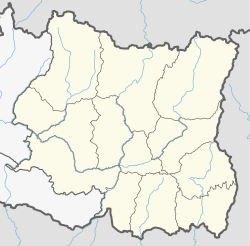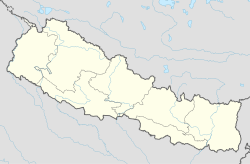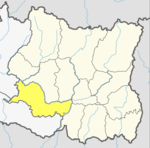Katari Municipality
Appearance
Katari Municipality
कटारी नगरपालिका | |
|---|---|
 | |
| Coordinates: 26°57′N 86°22′E / 26.95°N 86.37°E | |
| Country | Nepal |
| Province | Koshi |
| District | Udayapur |
| No. of wards | 14 |
| Established | 2014 |
| Incorporated (VDC) | Tribeni, Katari, Risku, Lekhani, Hardeni, Limpatar, Sorungchabise, Sirise |
| Government | |
| • Type | Mayor–council |
| • Body | Katari Municipality |
| • Mayor | Mr. Rajesh Chandra Shrestha (NC) |
| • Deputy Mayor | Mrs. Geeta Khadka (NCP) |
| • MP & Constituency | Udayapur 2 Ambar Bahadur Rayamajhi (UML) |
| • MLA & Constituency | Udayapur 2(B) Ram Kumar Khatri (NCP) |
| Area | |
• Total | 424.89 km2 (164.05 sq mi) |
| • Rank | 3rd in Province |
| Population (2011) | |
• Total | 56,146 |
| Time zone | UTC+05:45 (NPT) |
| Website | kataarimun |
Katari is a Municipality in Udayapur District in the Koshi province of south-eastern Nepal. It lies by the Tawa river (formed by unification of original Tawa river and Baidhyanath river) having the bridge of length 123.5m. This was established by merging two existing village development committees i.e. Triveni and Katari on 18 May 2014.[1][2] At the time of the 1991 Nepal census it had a population of 7230 people living in 1410 individual households.[3] Thirty years later, Katari had undergone rapid growth, achieving a population of 56,146 people by the 2011 census. There is a big Government school Triveni secondary school
Climate
[edit]| Climate data for Kurule Ghat, Katari, elevation 497 m (1,631 ft) | |||||||||||||
|---|---|---|---|---|---|---|---|---|---|---|---|---|---|
| Month | Jan | Feb | Mar | Apr | May | Jun | Jul | Aug | Sep | Oct | Nov | Dec | Year |
| Mean daily maximum °C (°F) | 20.9 (69.6) |
23.7 (74.7) |
28.7 (83.7) |
32.6 (90.7) |
33.2 (91.8) |
32.6 (90.7) |
30.9 (87.6) |
30.7 (87.3) |
30.2 (86.4) |
29.8 (85.6) |
26.4 (79.5) |
22.4 (72.3) |
28.5 (83.3) |
| Mean daily minimum °C (°F) | 8.5 (47.3) |
9.8 (49.6) |
13.8 (56.8) |
18.3 (64.9) |
21.0 (69.8) |
23.2 (73.8) |
23.4 (74.1) |
23.2 (73.8) |
22.0 (71.6) |
19.2 (66.6) |
13.1 (55.6) |
8.9 (48.0) |
17.0 (62.7) |
| Average precipitation mm (inches) | 13.0 (0.51) |
11.6 (0.46) |
22.3 (0.88) |
44.0 (1.73) |
75.5 (2.97) |
145.4 (5.72) |
272.3 (10.72) |
185.2 (7.29) |
131.7 (5.19) |
4.9 (0.19) |
7.8 (0.31) |
9.3 (0.37) |
923 (36.34) |
| Source 1: Australian National University[4] | |||||||||||||
| Source 2: Japan International Cooperation Agency (precipitation)[5] | |||||||||||||
See also
[edit]References
[edit]- ^ 72 new municipalities announced Archived 2014-06-18 at the Wayback Machine My Republica
- ^ Govt announces 72 new municipalities Archived 2014-10-06 at the Wayback Machine The Kathmandu Post
- ^ "Nepal Census 2001". Nepal's Village Development Committees. Digital Himalaya. Archived from the original on October 12, 2008. Retrieved 13 November 2008.
- ^ "CLIMATES OF NEPAL AND THEIR IMPLICATIONS FOR AGRICULTURAL DEVELOPMENT" (PDF). Australian National University. Archived from the original (PDF) on 23 October 2023. Retrieved 6 June 2024.
- ^ "ネパール国 全国貯水式水力発電所マスタープラン調査 ファイナルレポート" (PDF). Japan International Cooperation Agency. Archived from the original (PDF) on 6 April 2024. Retrieved 6 June 2024.
External links
[edit]



